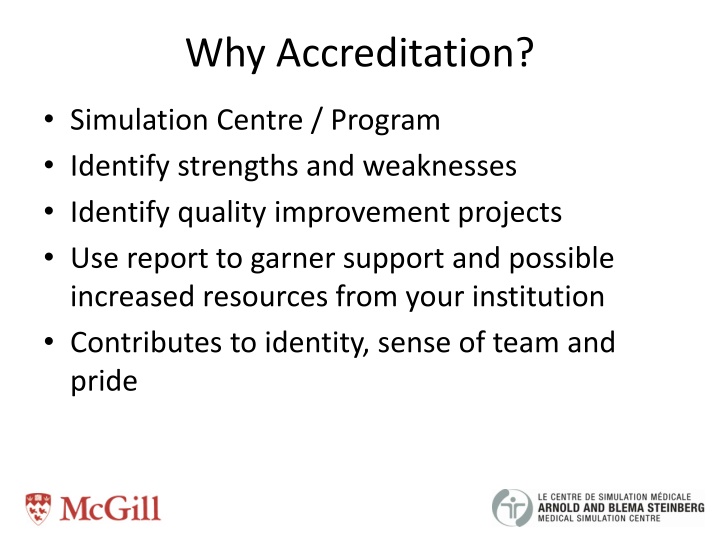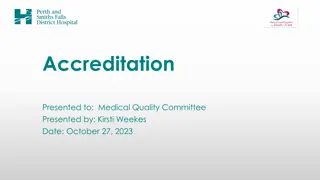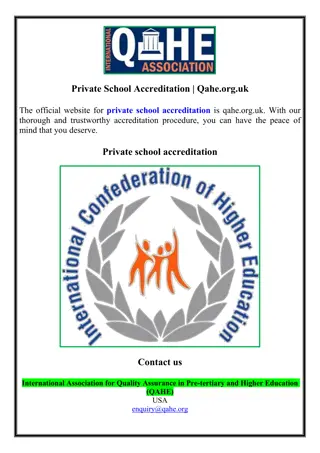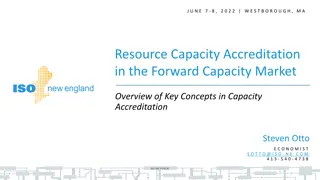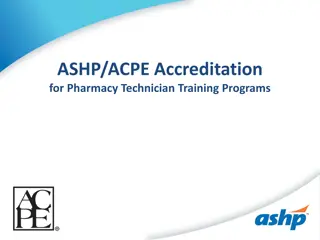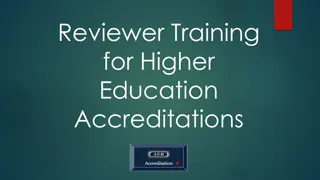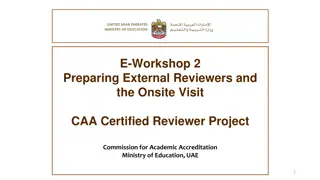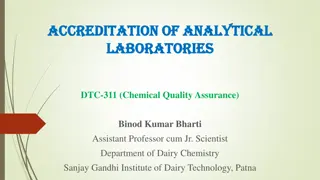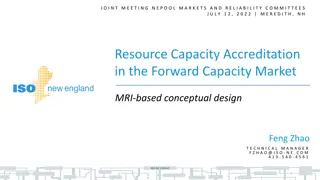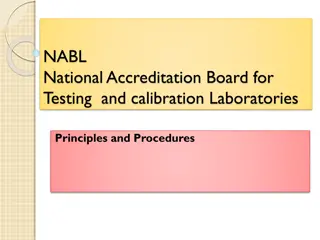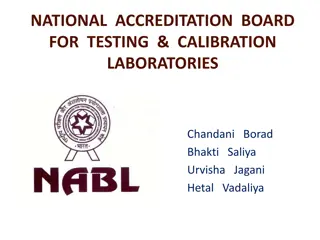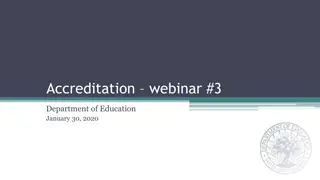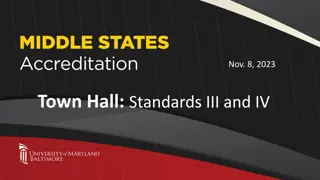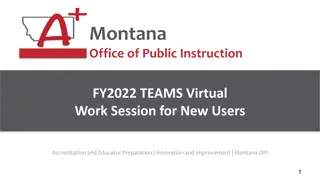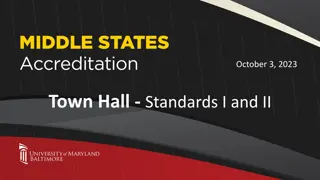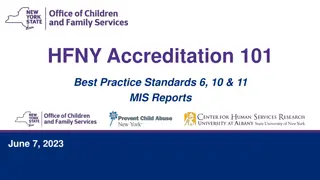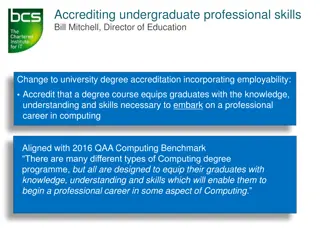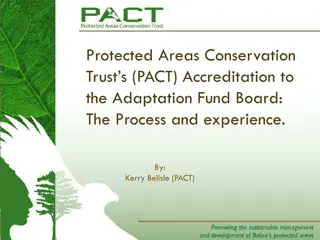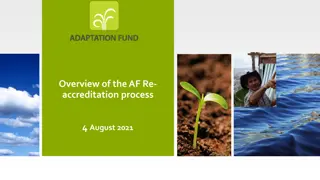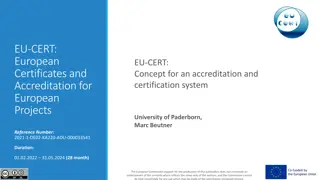Why Accreditation?
This content provides insights on the significance of accreditation for simulation center programs, including identifying strengths and weaknesses, quality improvement projects, and garnering support for resources. It also covers the pre-application process, data collection, application preparation, session forms, and examples from internal medicine residents, clerkship in general surgery, and interview skills in NUR.535.
Download Presentation

Please find below an Image/Link to download the presentation.
The content on the website is provided AS IS for your information and personal use only. It may not be sold, licensed, or shared on other websites without obtaining consent from the author.If you encounter any issues during the download, it is possible that the publisher has removed the file from their server.
You are allowed to download the files provided on this website for personal or commercial use, subject to the condition that they are used lawfully. All files are the property of their respective owners.
The content on the website is provided AS IS for your information and personal use only. It may not be sold, licensed, or shared on other websites without obtaining consent from the author.
E N D
Presentation Transcript
Why Accreditation? Simulation Centre / Program Identify strengths and weaknesses Identify quality improvement projects Use report to garner support and possible increased resources from your institution Contributes to identity, sense of team and pride
Pre-Application Process Review the application Assign Roles How to collect data Evaluation component of educational programs (faculty, learners, staff, equipment) Which educational activities to highlight Partners
Plan & Prepare the Application Data collection Decide on who will be involved and the scope of their involvement Establish timelines Writers Editors Survey Visit
Session Form Needs Assessment Level of learners Objectives Space Equipment Evaluation Scholarly Component
Internal Medicine Residents Central Line Insertion SIGN-IN February 5th, 2013 08H00 12H00 Name (please print name) Signature INSTRUCTORS/STAFF: 1. Dr. A 2. Dr. B RESIDENTS: 1. A. Smith 2. T. Charbonneau
Clerkship General Surgery SIGN-IN March 6th, 2013 13H00 17H00 Name (please print name) Signature INSTRUCTORS/STAFF: 1. Dr. C 2. STUDENTS: 1. 2. 3. 4. 5. 6.
NUR 535 Interview Skills SIGN-IN February 15th, 2013 08H00 16H00 Name (please print name) Signature INSTRUCTORS/STAFF: 1. M. Smith 2. 3. PARTICIPANTS: 1. 2. 3. 4. 5. 6.
# of Non- Learners (Candida tes, Sales Reps, Meetings ) # # Instruct ors / Faculty / Organiz ers INSTRUC TOR NAME PROGR AM COURSE/E VENT ACS CODE PROCED URES LEARN ER VISITS DATE HOURS #SP Difficult Airway Workshop Internal Med Central Line Insertion NUR 535 Interview Skills Core Clerkship General Surgery 17-JAN- 2013 CPD I Dr. D 4.25 Hifi 0 4 2 0 5-FEB- 2013 Residents R Dr. A 4 Hifi 0 5 2 0 Nursing Undergra duate 15-FEB- 2013 SP scenarios N M. Smith 8 5 6 1 0 6-MAR- 2013 Medical Students Technical skills M Dr. C 4 0 4 1 0
Table for Criterion 1.1 What is the Percentage of Use for Each Learner Group Over the Last 3 Years? 0.58% Learner Groups Served by the AEI Practicing Surgeons Yes No Physicians Yes No 3.69% Residents/Surgery Residents Yes No 26.10% Medical Students Yes No 32% Allied Health Professionals Yes No 13% Nurses Yes No 17.42% Others(Please list): Yes No Interdisciplinary 5.37% Industry and Special Events 1.85%
Table 1 Number of Activities Number of Learners Percentage of Learners Learner Types 10.05% 54 1005 Physicians (CME activities) 2989 29.90% 481 Residents 1667 16.68% 137 Allied Health Professionals 571 5.71% 397 Medical Students 18.91% 220 1890 Nursing 1874 18.75% 161 Others 9996 1450 100.00% Totals
Supporting Documentation Staffing Faculty Educational Resources Financial Resources Evaluation: educational content, learners, faculty, program
Pediatric Emergency - CRM Interdisciplinary EVALUATION FORM March 5th, 2013 Agree Completely Completely Disagree Agree Uncertain Disagree The objectives for this session were clear to me. The scenarios were realistic. The stations were well set up. The simulators were useful for practicing. During the debriefing session, I received clear, concise and pertinent information. The debriefing session was conducted with professionalism, was respectful for the participant and constructive. The content presented was relevant to my emergency practice. I can, now or in the nearest future, use correctly what I learned today. I am better prepared to address a similar scenario in the ER Overall, this was a positive experience
CPD Ultrasound Course March 14th, 2013 EVALUATION FORM Agree Completely Completely Disagree Agree Uncertain Disagree Please circle the appropriate response: The objectives of the session were made clear 5 4 3 2 1 The online videos were valuable 5 4 3 2 1 There was enough time for questions 5 4 3 2 1 The instructors were dynamic and knowledgeable 5 4 3 2 1 I would recommend this course to my colleagues 5 4 3 2 1 I am now comfortable performing this procedure on patients after taking this course 5 4 3 2 1 I had enough time to practice 5 4 3 2 1
Strongly Disagree Strongly Agree TASK TRAINERS Disagree Neutral Agree N/A 1.The task-trainers for lumbar puncture were realistic 2. The task-trainers for knee arthrocentesis were realistic 3. The task-trainers for shoulder arthrocentesis were realistic 4. The staff from the Medical were available and helpful 5. The facilities at the Medical were appropriate for this session
Station 2: Cardiac Arrest PE Station 2: Cardiac Arrest PE Station 2: Cardiac Arrest PE Station 2: Cardiac Arrest PE Station 2: Cardiac Arrest PE Station 2: Cardiac Medical Simulation Centre Pulmonary Embolism Sim Day - EVALUATION March 21st, 2012 Station 1: Radiation Scenario Agree Completely Completely Disagree Agree Uncertain Disagree 2 2 The scenario was interesting and realistic. The role of the standardized patient enhanced the learning experience. During the debriefing session, I received clear, concise and pertinent information. The debriefing session was conducted with professionalism, was respectful for the participant and constructive. 5 5 4 4 3 3 1 1 5 4 3 2 1 5 4 3 2 1 The content presented was relevant to my emergency practice. 5 4 3 2 1 I can, now or in the nearest future, use correctly what I learned today. 5 4 3 2 1 Station 2 : Cardiac Arrest Agree Completely Completely Disagree Agree Uncertain Disagree The scenario was interesting and realistic. 5 5 4 4 3 3 2 2 1 1 During the debriefing session, I received clear, concise and pertinent information. The debriefing session was conducted with professionalism, was respectful for the participant and constructive. 5 4 3 2 1 The content presented was relevant to my emergency practice. 5 4 3 2 1 I can, now or in the nearest future, use correctly what I learned today. 5 4 3 2 1
Survey Visit Meeting with Stakeholders Meeting with Faculty (Multidisciplinary) Meeting with Learners (Multidisciplinary)
